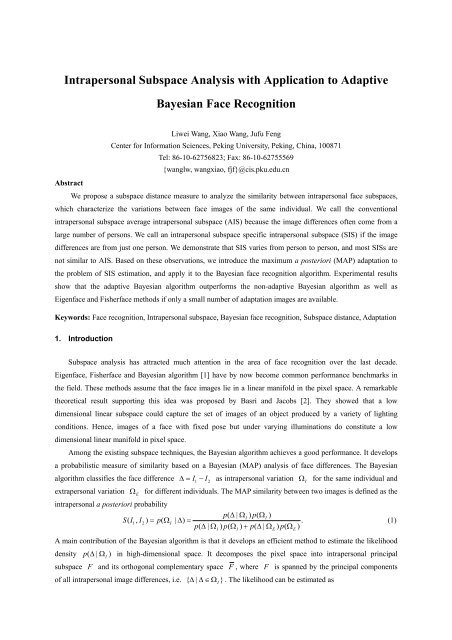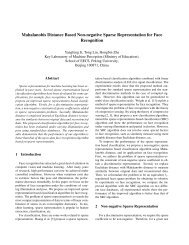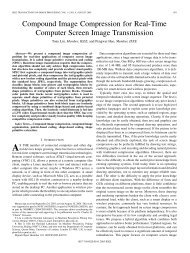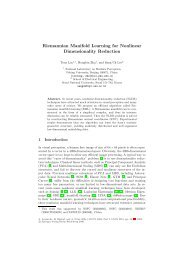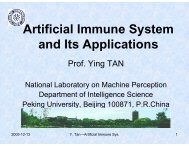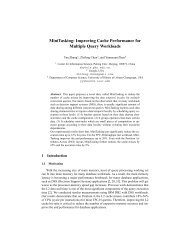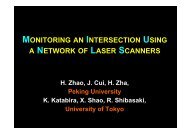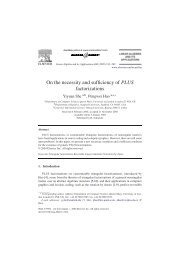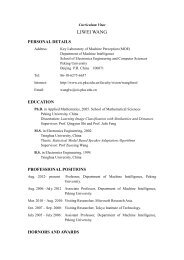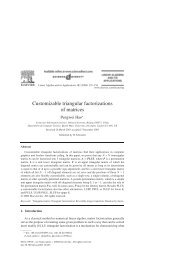Intrapersonal Subspace Analysis with Application to Adaptive ...
Intrapersonal Subspace Analysis with Application to Adaptive ...
Intrapersonal Subspace Analysis with Application to Adaptive ...
Create successful ePaper yourself
Turn your PDF publications into a flip-book with our unique Google optimized e-Paper software.
<strong>Intrapersonal</strong> <strong>Subspace</strong> <strong>Analysis</strong> <strong>with</strong> <strong>Application</strong> <strong>to</strong> <strong>Adaptive</strong><br />
Bayesian Face Recognition<br />
Liwei Wang, Xiao Wang, Jufu Feng<br />
Center for Information Sciences, Peking University, Peking, China, 100871<br />
Tel: 86-10-62756823; Fax: 86-10-62755569<br />
{wanglw, wangxiao, fjf}@cis.pku.edu.cn<br />
Abstract<br />
We propose a subspace distance measure <strong>to</strong> analyze the similarity between intrapersonal face subspaces,<br />
which characterize the variations between face images of the same individual. We call the conventional<br />
intrapersonal subspace average intrapersonal subspace (AIS) because the image differences often come from a<br />
large number of persons. We call an intrapersonal subspace specific intrapersonal subspace (SIS) if the image<br />
differences are from just one person. We demonstrate that SIS varies from person <strong>to</strong> person, and most SISs are<br />
not similar <strong>to</strong> AIS. Based on these observations, we introduce the maximum a posteriori (MAP) adaptation <strong>to</strong><br />
the problem of SIS estimation, and apply it <strong>to</strong> the Bayesian face recognition algorithm. Experimental results<br />
show that the adaptive Bayesian algorithm outperforms the non-adaptive Bayesian algorithm as well as<br />
Eigenface and Fisherface methods if only a small number of adaptation images are available.<br />
Keywords: Face recognition, <strong>Intrapersonal</strong> subspace, Bayesian face recognition, <strong>Subspace</strong> distance, Adaptation<br />
1. Introduction<br />
<strong>Subspace</strong> analysis has attracted much attention in the area of face recognition over the last decade.<br />
Eigenface, Fisherface and Bayesian algorithm [1] have by now become common performance benchmarks in<br />
the field. These methods assume that the face images lie in a linear manifold in the pixel space. A remarkable<br />
theoretical result supporting this idea was proposed by Basri and Jacobs [2]. They showed that a low<br />
dimensional linear subspace could capture the set of images of an object produced by a variety of lighting<br />
conditions. Hence, images of a face <strong>with</strong> fixed pose but under varying illuminations do constitute a low<br />
dimensional linear manifold in pixel space.<br />
Among the existing subspace techniques, the Bayesian algorithm achieves a good performance. It develops<br />
a probabilistic measure of similarity based on a Bayesian (MAP) analysis of face differences. The Bayesian<br />
algorithm classifies the face difference ∆= I1 − I2<br />
as intrapersonal variation Ω<br />
I<br />
for the same individual and<br />
extrapersonal variation<br />
Ω<br />
E<br />
for different individuals. The MAP similarity between two images is defined as the<br />
intrapersonal a posteriori probability<br />
p( ∆ | ΩI) p( ΩI)<br />
SI (<br />
1, I2) = p( ΩI<br />
| ∆ ) =<br />
.<br />
p( ∆| Ω ) p( Ω ) + p( ∆| Ω ) p( Ω )<br />
I I E E<br />
A main contribution of the Bayesian algorithm is that it develops an efficient method <strong>to</strong> estimate the likelihood<br />
density p( ∆| Ω<br />
I<br />
) in high-dimensional space. It decomposes the pixel space in<strong>to</strong> intrapersonal principal<br />
subspace F and its orthogonal complementary space F , where F is spanned by the principal components<br />
of all intrapersonal image differences, i.e. { ∆ | ∆∈Ω I<br />
}. The likelihood can be estimated as<br />
(1)
where<br />
y i = 1, 2, ,<br />
m<br />
i<br />
m 2 2<br />
1 yi<br />
ε ( ∆)<br />
exp( − ∑ ) exp( − )<br />
2 λ 2ρ<br />
i=<br />
1 i<br />
pˆ( ∆| Ω<br />
I<br />
) = [ ][ ].<br />
m<br />
m ( n−m)/ 2<br />
2 1/ 2 (2 πρ)<br />
(2 π)<br />
∏ λi<br />
i=<br />
1<br />
are principal components and<br />
(2)<br />
ε 2 ( ∆ ) is the residual. p( ∆ | Ω ) can be estimated in<br />
a similar way. The intrapersonal subspace plays a dominant role in Bayesian algorithm. It has been shown that<br />
maximizing the intrapersonal likelihood p( ∆ | Ω<br />
I<br />
) alone (called ML measure) is almost as effective as the<br />
MAP measure.<br />
Although the intrapersonal subspace represents the variations between images from the same individual, it<br />
is more appropriate <strong>to</strong> call it average intrapersonal subspace (AIS). Because the intrapersonal differences<br />
∆∈Ω<br />
I<br />
often come from a large number of persons. In this paper, we would also like <strong>to</strong> consider specific<br />
intrapersonal subspace (SIS). That is, we extract principal components from intrapersonal differences ∆ that<br />
come from one person. Thus AIS is, in a sense, the average of all SISs.<br />
Two questions naturally arise: Are two SISs “similar” <strong>to</strong> each other? And are SISs “similar” <strong>to</strong> the AIS? To<br />
study these similarity problems, we define a distance measure for linear subspaces. Experimental results show<br />
that SIS varies significantly from person <strong>to</strong> person and the average model AIS could not well represent all SISs.<br />
These results imply that AIS is a rather coarse model of the intrapersonal image variation.<br />
The above intrapersonal subspace analyses immediately find applications in face recognition algorithms.<br />
Mismatch between average model and specific model is a common phenomenon in many pattern recognition<br />
tasks. A widely used technique <strong>to</strong> handle this problem is adaptation. Adaptation combines a priori knowledge in<br />
the average model and, usually a small amount of person specific adaptation data <strong>to</strong> estimate an accurate person<br />
specific model. Adaptation has been quite successful in speech recognition [3]. It significantly improves the<br />
recognition rate for outlier speakers not well represented in the average model. Adaptation is often posed in a<br />
Bayesian (MAP) estimation framework [4]. It requires a prior distribution of the person specific model as well<br />
as the conditional distribution of the adaptation data.<br />
In this paper, we introduce the MAP adaptation <strong>to</strong> the Bayesian face recognition algorithm. We adaptively<br />
estimate SIS of each person in the gallery, and use SISs instead of the AIS <strong>to</strong> compute the probabilistic<br />
similarity (1). We define a prior distribution of the SIS and a conditional distribution of the adaptation data<br />
given the SIS. It can be shown that the MAP estimation of SIS is an eigenvalue problem. Experimental results<br />
demonstrate that the adaptive Bayesian algorithm outperforms the non-adaptive Bayesian algorithm as well as<br />
the Eigenface and Fisherface methods if only a small amount of adaptation images are available.<br />
E<br />
2. <strong>Intrapersonal</strong> <strong>Subspace</strong> <strong>Analysis</strong><br />
We will define a distance measure between two linear subspaces. It helps us <strong>to</strong> study the similarity of two<br />
SISs and that between an SIS and the AIS. The reason that we define a distance measure instead of using a<br />
similarity measure (e.g. the principal angles [5, p.349]) is that, this distance later plays an important role in the<br />
prior distribution of SIS in the MAP adaptation algorithm (see Section 3).<br />
Although a subspace can be seen as a set of points, common distance measures of sets are not appropriate<br />
for subspaces. For example, the minimum distance between two point sets A and B in Euclidean space,<br />
defined as<br />
d A B = a− b , is always zero when A and B are subspaces, since origin belongs <strong>to</strong><br />
( , ) min a ∈ A , b ∈ B
all subspaces. Another commonly used distance, the Hausdorff distance: d( A, B) = max min a− b is<br />
a∈A b∈B<br />
infinity (if A ≠ B ) due <strong>to</strong> the unboundedness of linear subspace. Intuitively, the distance/similarity of two<br />
subspaces should reflect the difference between their “directions”. That is, if two subspaces nearly coincide,<br />
they should have a small distance; if they are almost perpendicular <strong>to</strong> each other, they have a large distance.<br />
These intuitive ideas will be incorporated in our definition of subspace distance.<br />
To begin <strong>with</strong>, consider two linear subspaces<br />
U<br />
and V in<br />
d<br />
R . We first assume that<br />
U<br />
and V have<br />
the same dimensionality, say m (m ≤ d ). Let u , u ,,<br />
m<br />
and v , v ,, vm<br />
be standard orthogonal bases<br />
of U and V respectively. Let du (<br />
i<br />
, V) denote the so-called L2<br />
-Hausdorff distance from the end point of<br />
vec<strong>to</strong>r<br />
u i<br />
<strong>to</strong> subspace V . That is<br />
1 2<br />
u<br />
1 2<br />
du ( , V) = min u− v.<br />
(3)<br />
i<br />
We then define the subspace distance dUV ( , ) for m -dimensional subspaces U and V as<br />
v∈V<br />
i<br />
m<br />
2<br />
( , ) (<br />
i<br />
, ).<br />
i=<br />
1<br />
dUV = ∑ d u V<br />
(4)<br />
Since v1, v2, , vm<br />
is a standard orthogonal basis of V , it is easy <strong>to</strong> see that<br />
m 2 m T 2 m m<br />
T 2<br />
i i j i<br />
i= 1 j= 1 i= 1 j=<br />
1<br />
∑ ∑ ∑∑ j<br />
(5)<br />
dUV ( , ) = [ u − ( u v) ] = m−<br />
( u v) .<br />
We need <strong>to</strong> check some desired properties of this subspace distance. First of all, in the definition, we use a<br />
particular standard orthogonal basis u1, u2, , um<br />
, but the distance is invariant <strong>to</strong> the standard orthogonal basis.<br />
Theorem 1<br />
The subspace distance defined above is invariant <strong>to</strong> the choice of standard orthogonal basis.<br />
Proof.<br />
Let u1, u2,<br />
, um<br />
and u1, u2, , um<br />
be two standard orthogonal bases of U . Let v1, v2, , vm<br />
be a<br />
standard orthogonal basis of V . To prove the theorem, it suffices <strong>to</strong> show that<br />
or equivalently<br />
m m m m<br />
T 2 T 2<br />
(<br />
i j) (<br />
i j)<br />
i= 1 j= 1 i= 1 j=<br />
1<br />
∑∑ ∑∑ .<br />
m− u v = m−<br />
u v<br />
m m m m<br />
∑∑<br />
∑∑ <br />
T 2 T 2<br />
( u v ) = ( u v ) .<br />
i j i j<br />
i= 1 j= 1 i= 1 j=<br />
1<br />
(6)<br />
(7)<br />
In fact, we can show that, for every j , j = 1, 2, ,<br />
m,<br />
v j<br />
m<br />
∑<br />
T 2 T 2<br />
( ui vj) = ∑( u i<br />
vj)<br />
.<br />
m<br />
i= 1 i=<br />
1<br />
To see that the above equality holds, applying Parseval’s theorem <strong>to</strong> the vec<strong>to</strong>r , where Pv is the<br />
projection of<br />
on<strong>to</strong> subspace U . And this completes the<br />
proof. ٱ Pv<br />
U j<br />
U j<br />
Two additional properties of the distance are immediate from (4) and (5): the nonnegativity dUV ( , ) ≥ 0,<br />
and the symmetry<br />
(5), it is easy <strong>to</strong> see that<br />
dUV ( , ) = dVU ( , ). We also address the minimum and maximum of the distance. By (4) and<br />
0 ≤ dUV ( , ) ≤ m; dUV ( , ) = 0 iff U = V ; and dUV ( , )<br />
(8)<br />
= m iff U ⊥ V , that is,<br />
each vec<strong>to</strong>r in U is perpendicular <strong>to</strong> V and vice versa. The distance measure agrees <strong>with</strong> the
afore-mentioned intuitive idea that it reflects the difference between the directions of the subspaces.<br />
The definition of subspace distance can be generalized <strong>to</strong> the case in which U and V have different<br />
dimensions. Let U and V be m and n -dimensional subspaces, u1, u2,<br />
, um<br />
and v1, v2, , vn<br />
be<br />
standard orthogonal bases of U and V respectively. Define the directional distance from U <strong>to</strong> V as<br />
<br />
dUV d u V m u vj (9)<br />
m m n<br />
2 T 2<br />
( , ) = ∑ (<br />
i, ) = −∑∑( i<br />
) .<br />
i= 1 i= 1 j=<br />
1<br />
Clearly, the directional distance is not symmetry. We define the symmetric distance between<br />
<br />
dUV dUV dVU mn u v<br />
m n<br />
T 2<br />
( , ) = max( ( , ), ( , )) = max( , ) −∑∑( i j) .<br />
i= 1 j=<br />
1<br />
U<br />
and V as<br />
(10)<br />
It is easy <strong>to</strong> check that this distance is also invariant <strong>to</strong> the choice of standard orthogonal basis and the maximum<br />
of<br />
dUV ( , ) is max( mn , ) .<br />
We use this subspace distance measure <strong>to</strong> study the similarity between two SISs and that between an SIS<br />
and the AIS. Two subspaces are said <strong>to</strong> be similar if dUV ( , ) max( mn , ) ≤ 1/2.<br />
The experimental results are given in Section 4, where we show that SIS varies from person <strong>to</strong> person, and<br />
most SISs are not similar <strong>to</strong> AIS.<br />
3. <strong>Application</strong>: MAP Adaptation of SIS<br />
The dissimilarity between most SISs and AIS implies that the average model AIS does not well represent<br />
each person’s subspace. Thus one may expect a performance improvement if we can estimate accurate SISs for<br />
all individuals in the gallery, and use SISs instead of a single AIS in the Bayesian face recognition algorithm.<br />
However, such an accurate estimation often needs a large number of face images of each person, which are not<br />
available in most applications. Adaptation is a powerful <strong>to</strong>ol <strong>to</strong> solve this problem. It promises <strong>to</strong> present a good<br />
estimate of the person specific model but requires only a small amount of data.<br />
The advantage of adaptation is due <strong>to</strong> the fact that it combines the prior knowledge of the person specific<br />
model (usually contained in the average model) and the adaptation data. Bayesian estimation provides a natural<br />
framework for adaptation, which is often called MAP adaptation. In the situation of SIS adaptation, let<br />
an SIS. MAP adaptation requires the definition of a prior distribution of V denoted by<br />
conditional distribution of the face differences<br />
p( ∆ , ∆ , , ∆ | V)<br />
. The MAP estimate of V is<br />
1 2<br />
k<br />
pV ( )<br />
V<br />
be<br />
, and the<br />
Vˆ = arg max p( V | ∆ , ∆ , , ∆ ) = arg max p( ∆ , ∆ , , ∆ | V) ⋅ p( V).<br />
MAP 1 2 k 1 2 k<br />
V<br />
V<br />
(11)<br />
In order <strong>to</strong> incorporate the a priori knowledge contained in the average model (AIS) in<strong>to</strong> the prior<br />
distribution pV ( ), we define pV ( ) as follows. Let V0<br />
be the AIS.<br />
def<br />
1<br />
2<br />
pV ( ) = exp( − d ( V, V0<br />
)).<br />
(12)<br />
Z<br />
where Z is a normalizing constant, and<br />
dVV ( ,<br />
0<br />
)<br />
is the subspace distance defined in Section 2. According <strong>to</strong><br />
the discussion in the previous section, pV ( ) reflects the similarity between SIS V and AIS V<br />
0<br />
.<br />
Before giving the definition of the conditional distribution of image differences<br />
p( ∆ , ∆ , , ∆ | V)<br />
, we<br />
consider an extreme case of the MAP adaptation: There is no prior knowledge of V . In this situation, MAP<br />
estimation (11) reduces <strong>to</strong> ML estimation<br />
1 2<br />
k
V ˆ = arg max p ( ∆ , ∆ , , ∆ | V ).<br />
ML<br />
V<br />
1 2<br />
k<br />
(13)<br />
That is, given face differences<br />
∆1, ∆2, , ∆k<br />
, compute the subspace <strong>with</strong>out any prior knowledge. Note that<br />
PCA deals <strong>with</strong> exactly such a problem, and the Bayesian face recognition algorithm uses PCA <strong>to</strong> compute the<br />
AIS. For this reason, we would like <strong>to</strong> define the conditional distribution<br />
p( ∆1, ∆2, , ∆ k<br />
| V)<br />
in accordance<br />
<strong>with</strong> PCA. It is well known that PCA presents a subspace, which is the least square approximation of the data.<br />
That is, given<br />
where<br />
d( ∆ , V)<br />
i<br />
∆1, ∆2, , ∆k<br />
, the principal subspace <strong>with</strong> a fixed dimension is given by<br />
k<br />
ˆ 2<br />
PCA<br />
= arg min ∑ d ( ∆i<br />
, V).<br />
V<br />
i=<br />
1<br />
V<br />
was defined in (3). Accordingly, we define the conditional distribution as<br />
k<br />
1<br />
2<br />
p( ∆1, ∆2, , ∆<br />
k<br />
| V) = exp( − d ( ∆i, )).<br />
′<br />
∑ V (15)<br />
Z i=<br />
1<br />
where Z ′ is also a normalizing constant. Hence, if no prior knowledge is available, the ML estimation is PCA.<br />
Combining (12) and (15), the MAP adaptation of SIS V , given the AIS V0<br />
is<br />
k<br />
2<br />
2<br />
exp( − d ( ∆i<br />
, V))<br />
exp( −d<br />
( V, V0))<br />
∑<br />
i=<br />
1<br />
2<br />
k<br />
0 ∑<br />
2<br />
i=<br />
1<br />
Vˆ MAP<br />
= arg max ⋅ = arg min[ d ( V, V ) + d ( ∆<br />
i<br />
, V)].<br />
(16)<br />
V Z<br />
Z′<br />
V<br />
It can be shown that the Bayesian adaptation (16) is <strong>to</strong> solve the eigenvalue problem of matrix M :<br />
k<br />
n<br />
T<br />
T<br />
i i<br />
ww<br />
i i<br />
i= 1 i=<br />
1<br />
(14)<br />
M = ∑∆ ∆ + ∑ .<br />
(17)<br />
where wi<br />
, i = 1, 2, ,<br />
n, are base vec<strong>to</strong>rs of V0<br />
. If we fix the dimensionality of SIS <strong>to</strong> be m , V ˆMAP is the<br />
principal subspace spanned by the first<br />
m eigenvec<strong>to</strong>rs of M .<br />
Using MAP adaptation, we may have an accurate estimate of the SIS and the corresponding eigenvalues of<br />
each individual in the gallery. These SISs will substitute for the AIS in the Bayesian face algorithm <strong>to</strong> improve<br />
the performance. We call this method adaptive Bayesian algorithm.<br />
4. Experimental Results<br />
The goal of the first experiment is <strong>to</strong> study the similarity between any two SISs and between SIS and AIS.<br />
All face images are from Yale database. We compute an AIS and a number of SISs by PCA on image differences.<br />
We next calculate the normalized subspace distance dUV ( , ) max( mn , ) for all SIS pairs and SIS-AIS pairs.<br />
The his<strong>to</strong>grams of dUV ( , ) max( mn , ) of the two kinds are depicted in Fig. 1. Recall that 1/2 is defined <strong>to</strong><br />
be the upper bound of similarity. The results illustrate that almost all SISs are not similar <strong>to</strong> each other and most<br />
SISs are not similar <strong>to</strong> AIS.<br />
The purpose of the second experiment is <strong>to</strong> compare the performance of the adaptive Bayesian algorithm <strong>to</strong><br />
non-adaptive Bayesian algorithm as well as the Eigenface, Fisherface methods. All the models including the AIS<br />
are trained by images from FERET database. Gallery and Probe set contain images all from Yale database. In<br />
adaptation, we use images in the gallery and the AIS <strong>to</strong> compute SISs for all persons. Then the Bayesian<br />
similarities are calculated using the SIS of each person instead of the AIS. We demonstrate how the performance<br />
of our algorithm depends on the number of adaptation data. To make the results reliable, we randomly construct<br />
gallery and repeat it ten times <strong>to</strong> obtain an average recognition rate. The result is plotted in Fig. 2. The adaptive<br />
Bayesian algorithm outperforms all other methods when more than four adaptation images are available.
(a)<br />
Fig. 1 His<strong>to</strong>grams of distances between (a) SIS and SIS, (b) SIS and AIS.<br />
(b)<br />
Fig. 2. Performance comparison of adaptive Bayesian algorithm <strong>with</strong> three others.<br />
5. Conclusion<br />
We propose a subspace distance measure <strong>to</strong> study the similarity of intrapersonal subspaces. Experimental<br />
results show that AIS does not well represent SISs. We then apply the MAP adaptation <strong>to</strong> the estimation of<br />
intrapersonal subspaces. It is demonstrated that the adaptive Bayesian algorithm achieves a higher accuracy than<br />
the non-adaptive Bayesian algorithm as well as Eigenface and Fisherface when a few images are available.<br />
Acknowledgement<br />
This work is supported by the National Natural Science Foundation of China 60175004.<br />
References<br />
[1] B. Moghaddam, Bayesian Face Recognition, Pattern Recognition 13 (11) (2000) 1771-1782.<br />
[2] R. Basri, D. Jacobs, Lambertian Reflectance and Linear <strong>Subspace</strong>s. IEEE Trans PAMI. 25(2) (2003) 218-233.<br />
[3] P.C. Woodland, Speaker Adaptation for Continuous Density HMMs: A Review. ISCAITR Workshop on Adaptation<br />
Methods for Speech Recognition, 2001.<br />
[4] C.H.Lee, C.H.Lin, B.H.Juang, A study on speaker adaptation of the parameters of continuous density hidden Markov<br />
models, IEEE.Trans.Signal Process. 39(4) (1991) 806-814.<br />
[5] H. Hotelling, Relations between Two Sets of Variates. Biometrika 28 (3/4) (1936) 321-377.


